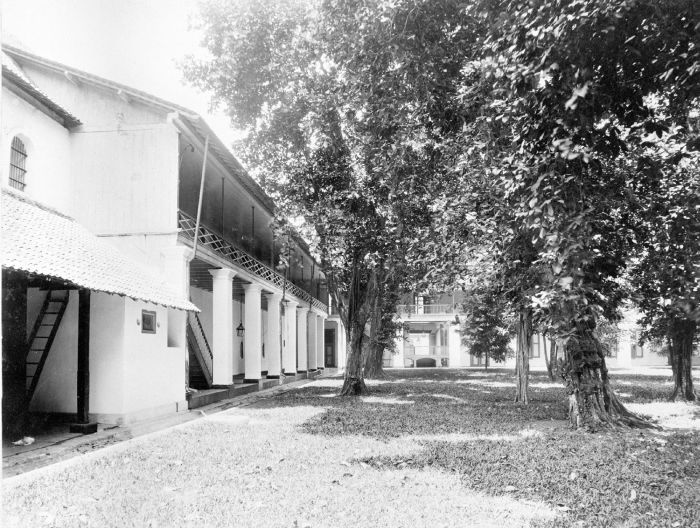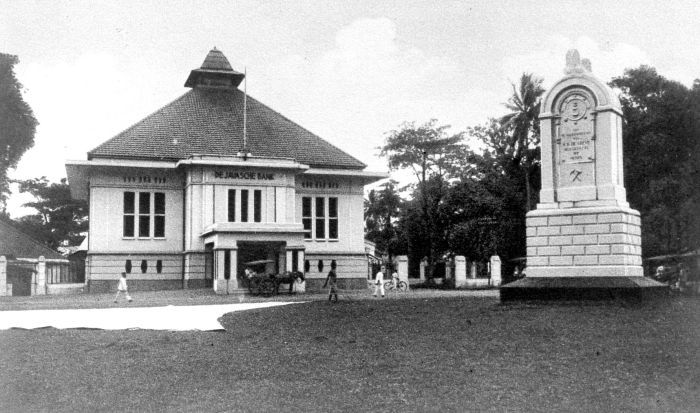|
Museum Bank Indonesia
Bank Indonesia Museum (, occasionally called Museum BI), also called in English officially as BI Museum, is a bank museum located in Jakarta, Indonesia. It was founded by Bank Indonesia and opened on 21 July 2009. The museum is housed in a heritage building in Jakarta Old Town that had been the first headquarters of the Netherlands Indies gulden (De Javasche bank), the central bank of the Dutch East Indies. The bank was nationalized as Bank Indonesia in 1953, after Indonesia gained its independence. It is located next to Mandiri Museum. History De Javasche Bank was formed in 1828 as a circulation bank of the Dutch East Indies and was responsible for issuing Netherlands Indies Guldens. The building stood in a plot that had been Batavia's Inner Hospital (in Dutch: "Binnenhospital" named "inner" due to its location being inside the wall), which was built in the early 18th century and was abandoned in 1780, as the central hospital was moved to Weltevreden. The building was sold to ... [...More Info...] [...Related Items...] OR: [Wikipedia] [Google] [Baidu] |
Jakarta Barat
Jakarta (; , Betawi language, Betawi: ''Jakartè''), officially the Special Capital Region of Jakarta (; ''DKI Jakarta'') and formerly known as Batavia, Dutch East Indies, Batavia until 1949, is the capital and largest city of Indonesia and an autonomous region at the provincial level. Lying on the northwest coast of Java, the world's List of islands by population, most populous island, Jakarta is the List of cities in ASEAN by population, largest metropole in Southeast Asia and serves as the diplomatic capital of ASEAN. The Special Region has a status equivalent to that of a Provinces of Indonesia, province and is bordered by two other provinces: West Java to the south and east; and Banten to the west. Its coastline faces the Java Sea to the north, and it shares a maritime border with Lampung to the west. Jakarta metropolitan area, Jakarta's metropolitan area is List of ASEAN country subdivisions by GDP, ASEAN's second largest economy after Singapore. In 2023, the city's Gros ... [...More Info...] [...Related Items...] OR: [Wikipedia] [Google] [Baidu] |
Proclamation Of Indonesian Independence
The Proclamation of Indonesian Independence (, or simply ''Proklamasi'') was read at 10:00 Tokyo Standard Time on Friday 17 August 1945 in Jakarta. The declaration marked the start of the diplomatic and armed resistance of the Indonesian National Revolution, fighting against the forces of the Netherlands and pro-Dutch civilians, until the latter officially acknowledged Indonesia's independence in 1949. The document was signed by Sukarno and Mohammad Hatta, who were appointed president and vice-president respectively the following day. The date of the Proclamation of Indonesian Independence was made a public holiday by a government decree issued on 18 June 1946. Background The beginnings of the independence movement In 1918, the Dutch authorities in the Dutch East Indies established a partly-elected People's Council, the '' Volksraad'', which for the first time gave Indonesian nationalists a voice. Meanwhile, Indonesian students studying in the Netherlands formed the Perhimpo ... [...More Info...] [...Related Items...] OR: [Wikipedia] [Google] [Baidu] |
Colonial Architecture In Jakarta
Colonial buildings and structures in Jakarta include those that were constructed during the Dutch East Indies, Dutch colonial period of Indonesia. The period (and the subsequent style) succeeded the earlier period when Jakarta (known then as Jayakarta/Jacatra), governed by the Sultanate of Banten, were completely eradicated and replaced with a walled city of Batavia. The dominant styles of the colonial period can be divided into three periods: the Dutch Golden Age (17th to late 18th century), the transitional style period (late 18th century – 19th century), and Dutch modernism (20th century). Dutch colonial architecture in Jakarta is apparent in buildings such as houses or villas, churches, civic buildings, and offices, mostly concentrated in the administrative city of Central Jakarta and West Jakarta. Below is a list of colonial buildings and structures found in Jakarta. The list is sorted alphabetically according to its official (local) name. The list can also be sorted to eac ... [...More Info...] [...Related Items...] OR: [Wikipedia] [Google] [Baidu] |
Museums Established In 1998
A museum is an institution dedicated to displaying or preserving culturally or scientifically significant objects. Many museums have exhibitions of these objects on public display, and some have private collections that are used by researchers and specialists. Museums host a much wider range of objects than a library, and they usually focus on a specific theme, such as the arts, science, natural history or local history. Public museums that host exhibitions and interactive demonstrations are often tourist attractions, and many draw large numbers of visitors from outside of their host country, with the most visited museums in the world attracting millions of visitors annually. Since the establishment of the earliest known museum in ancient times, museums have been associated with academia and the preservation of rare items. Museums originated as private collections of interesting items, and not until much later did the emphasis on educating the public take root. Etymology Th ... [...More Info...] [...Related Items...] OR: [Wikipedia] [Google] [Baidu] |
Bank Indonesia Museum, Surabaya
Bank Indonesia Museum () is a bank museum located in Surabaya, Indonesia. It was officially founded by Bank Indonesia and was opened on 27 January 2012 after its restoration. The museum occupies a building formerly known as ''De Javasche Bank'', the central bank of Dutch East Indies. After the Indonesian Independence the building continued to function as the Bank Indonesia's branch in Surabaya until 1973. The museum is closed on Monday and public holidays. It has no entrance fee. History De Javasche Bank opened a branch in Surabaya on 14 September 1829. By 1904 the original building that occupied the plot was demolished and was rebuilt with an area of 1,000 square metres. It was designed in a similar manner to De Javasche Bank headquarter in Batavia, with Neo-Renaissance architecture and Javanese adornment. The museum The museum has 3 floors and displays the history of the banking system in Indonesia, old photos of Surabaya and old currencies. The museum display is divided int ... [...More Info...] [...Related Items...] OR: [Wikipedia] [Google] [Baidu] |
Bank Indonesia Museum, Padang
Bank Indonesia Museum of Padang () is a former bank building located in Padang, Indonesia. The building was built on March 31, 1921 as the Padang branch office of De Javasche Bank before it was taken over by Bank Indonesia on July 1, 1953. Completed in 1925, the building was initially used as the new building for De Javasche Bank, replacing the old de Javasche Bank building at Jalan Nipah, near Padang Beach. The location was formerly the center of the financial offices, commerce and military in colonial Padang. Old colonial buildings from the Dutch East Indies period can still be found lining the waterfront street of Batang Arau. History Padang is one of the great cities of Sumatra. Located on the west coast of Sumatra, Padang evolved into a commercial and military city between the 18th and 19th centuries. In 1864, De Javasche Bank officially opened a branch office in Padang. This was the third branch of de Javasche Bank in the Netherlands Indies after Semarang and Surabaya, an ... [...More Info...] [...Related Items...] OR: [Wikipedia] [Google] [Baidu] |
List Of Museums And Cultural Institutions In Indonesia
This list includes many museums and cultural institutions in Indonesia (including aquariums, zoos, and botanical gardens, following the definition of the International Council of Museums). Heritage buildings such as candi, mosques, colonial churches and buildings with no ''site museum'' should not be placed in the list. History Colonial period Before the 20th-century, there was little interest in the study of the native culture of Indonesia by the colonial government. Most anthropologic studies were done by a few non-governmental institutions and individuals. Among the non-governmental institution was the Batavian Society of Arts and Science, which established a museum for Indonesian culture and history. Individuals e.g. Sir Stamford Raffles and Dr. Snoeck Hourgrogne wrote valuable studies on native culture and history before the 20th-century. The first museum in Indonesia seems to have been that built by Rumphius in Ambon, built in 1662. Nothing remains of it except ... [...More Info...] [...Related Items...] OR: [Wikipedia] [Google] [Baidu] |
List Of Colonial Buildings And Structures In Jakarta
Colonial buildings and structures in Jakarta include those that were constructed during the Dutch East Indies, Dutch colonial period of Indonesia. The period (and the subsequent style) succeeded the earlier period when Jakarta (known then as Jayakarta/Jacatra), governed by the Sultanate of Banten, were completely eradicated and replaced with a walled city of Batavia. The dominant styles of the colonial period can be divided into three periods: the Dutch Golden Age (17th to late 18th century), the transitional style period (late 18th century – 19th century), and Dutch modernism (20th century). Dutch colonial architecture in Jakarta is apparent in buildings such as houses or villas, churches, civic buildings, and offices, mostly concentrated in the administrative city of Central Jakarta and West Jakarta. Below is a list of colonial buildings and structures found in Jakarta. The list is sorted alphabetically according to its official (local) name. The list can also be sorted to eac ... [...More Info...] [...Related Items...] OR: [Wikipedia] [Google] [Baidu] |
Dutch East India Company
The United East India Company ( ; VOC ), commonly known as the Dutch East India Company, was a chartered company, chartered trading company and one of the first joint-stock companies in the world. Established on 20 March 1602 by the States General of the Netherlands amalgamating Voorcompagnie, existing companies, it was granted a 21-year monopoly to carry out trade activities in Asia. Shares in the company could be purchased by any citizen of the Dutch Republic and subsequently bought and sold in open-air secondary markets (one of which became the Amsterdam Stock Exchange). The company possessed quasi-governmental powers, including the ability to wage war, imprison and execute convicts, negotiate treaties, strike Coinage of the Dutch East India Company, its own coins, and establish colonies. Also, because it traded across multiple colonies and countries from both the East and the West, the VOC is sometimes considered to have been the world's first multinational corporation. St ... [...More Info...] [...Related Items...] OR: [Wikipedia] [Google] [Baidu] |
Susilo Bambang Yudhoyono
Susilo Bambang Yudhoyono (born 9 September 1949), commonly referred to as SBY, is an Indonesian politician and retired Indonesian Army, army general who served as the sixth president of Indonesia from 2004 to 2014 and the second president of Indonesia from the military after Suharto. He founded the Democratic Party (Indonesia), Democratic Party of Indonesia and served as its 4th chairman from 2014 until 2020. He also served as the 8th and 10th Coordinating Ministry for Political and Security Affairs#List of ministers, coordinating minister for political and security affairs from 2000 until 2001 and again from 2001 until 2004. He also served as the president of the Assembly and chair of the Council of the Global Green Growth Institute. He was also the former chairman of ASEAN due to Indonesia hosting of the 18th and 19th ASEAN Summits. Yudhoyono won the 2004 Indonesian presidential election, 2004 presidential election—the first Direct election, direct presidential election in In ... [...More Info...] [...Related Items...] OR: [Wikipedia] [Google] [Baidu] |







